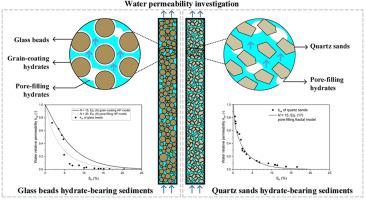当前位置:
X-MOL 学术
›
Gas Sci. Eng.
›
论文详情
Our official English website, www.x-mol.net, welcomes your feedback! (Note: you will need to create a separate account there.)
Investigation of permeability and growth habits in hydrate-bearing porous media considering pore irregularity
Gas Science and Engineering ( IF 5.285 ) Pub Date : 2024-02-15 , DOI: 10.1016/j.jgsce.2024.205241 Zelin Xu , Gang Li , Xiaosen Li , Xinwang Li , Tao Lv , Pengfei Shen
Gas Science and Engineering ( IF 5.285 ) Pub Date : 2024-02-15 , DOI: 10.1016/j.jgsce.2024.205241 Zelin Xu , Gang Li , Xiaosen Li , Xinwang Li , Tao Lv , Pengfei Shen

|
The permeability of hydrate-bearing sediments critically affects gas production rate and efficiency. Reported permeability from artificial and natural cores is widely scattered owing to porous media particle size, porosity and hydrate saturation (), but pore irregularity was ignored. Therefore, analyzing the effects of pore irregularity on growth habits and permeability is crucial. In this study, we used glass beads (represent regular pores, well-rounded grain) and quartz sands (represent irregular pores, angular grain) with nearly the same particle size distribution (mean and median particle size is around 103 μm and 100 μm, respectively) and porosity (about 39%) as the porous media, to determine the hydrate growth habits and the permeability as a function of . First, the hexagonal prism model (HP model) was proposed for well-rounded porous media with regular pores, and a fractal model was recommended for angular porous media with irregular pores. The fitting permeability reduction exponents () in these two models indicated that both pore-filling (5% < < 25%, = 30) and grain-coating (0 < < 5%, = 15) hydrates existed within glass beads, and only pore-filling (0 < < 25%, = 15) hydrates were dominant in quartz sands. The permeability values in glass beads were consistently higher than those in quartz sands due to more pore connections, smooth surfaces, and grain-coating hydrates in glass beads. This study provides the permeability reduction model based on pore irregularity.
中文翻译:

考虑孔隙不规则性的含水合物多孔介质的渗透率和生长习性研究
含水合物沉积物的渗透性严重影响天然气产量和效率。由于多孔介质粒径、孔隙度和水合物饱和度(),人造和天然岩心报告的渗透率广泛分散,但忽略了孔隙不规则性。因此,分析孔隙不规则性对生长习性和渗透性的影响至关重要。在这项研究中,我们使用的玻璃珠(代表规则的孔隙,圆润的颗粒)和石英砂(代表不规则的孔隙,有角的颗粒)具有几乎相同的粒径分布(平均和中值粒径约为 103 μm 和 100 μm,分别)和孔隙度(约 39%)作为多孔介质,以确定水合物生长习性和渗透率作为 的函数。首先,针对规则孔隙的圆形多孔介质提出了六棱柱模型(HP模型),针对不规则孔隙的有角多孔介质提出了分形模型。这两个模型中拟合的渗透率降低指数()表明,玻璃珠内同时存在孔隙填充水合物(5% < < 25%,= 30)和颗粒涂层水合物(0 < < 5%,= 15),并且仅存在于玻璃珠中。孔隙填充(0 < < 25%,= 15)水合物在石英砂中占主导地位。由于玻璃珠中有更多的孔隙连接、光滑的表面和颗粒涂层水合物,玻璃珠的渗透率值始终高于石英砂。本研究提供了基于孔隙不规则性的渗透率降低模型。
更新日期:2024-02-15
中文翻译:

考虑孔隙不规则性的含水合物多孔介质的渗透率和生长习性研究
含水合物沉积物的渗透性严重影响天然气产量和效率。由于多孔介质粒径、孔隙度和水合物饱和度(),人造和天然岩心报告的渗透率广泛分散,但忽略了孔隙不规则性。因此,分析孔隙不规则性对生长习性和渗透性的影响至关重要。在这项研究中,我们使用的玻璃珠(代表规则的孔隙,圆润的颗粒)和石英砂(代表不规则的孔隙,有角的颗粒)具有几乎相同的粒径分布(平均和中值粒径约为 103 μm 和 100 μm,分别)和孔隙度(约 39%)作为多孔介质,以确定水合物生长习性和渗透率作为 的函数。首先,针对规则孔隙的圆形多孔介质提出了六棱柱模型(HP模型),针对不规则孔隙的有角多孔介质提出了分形模型。这两个模型中拟合的渗透率降低指数()表明,玻璃珠内同时存在孔隙填充水合物(5% < < 25%,= 30)和颗粒涂层水合物(0 < < 5%,= 15),并且仅存在于玻璃珠中。孔隙填充(0 < < 25%,= 15)水合物在石英砂中占主导地位。由于玻璃珠中有更多的孔隙连接、光滑的表面和颗粒涂层水合物,玻璃珠的渗透率值始终高于石英砂。本研究提供了基于孔隙不规则性的渗透率降低模型。



























 京公网安备 11010802027423号
京公网安备 11010802027423号